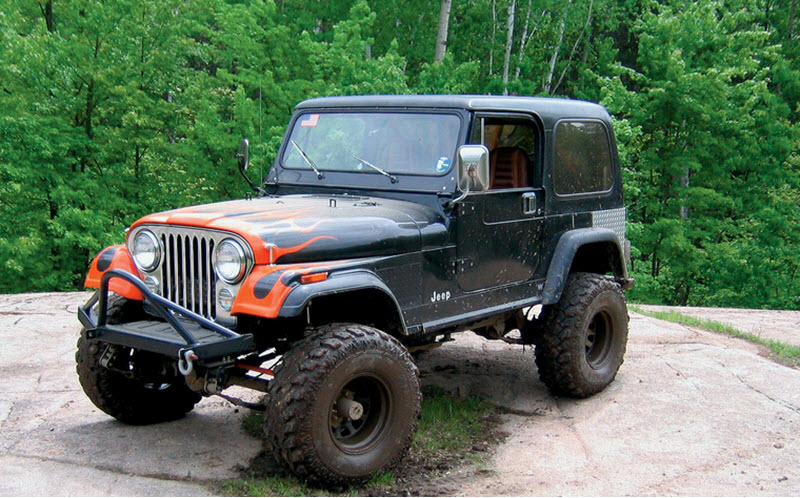Jeep CJ
The Jeep CJ line was a series and a range of small, open-bodied off-road vehicles and compact pickup trucks built and sold by Jeep from 1945 to 1986.
All CJ:s had a separate body and frame, rigid live axels both front and rear, and a tapering nose design with flared fenders. The CJ:s used leaf-springs (not coil springs) in the front and in the rear. The windshield was fold-flat, and it was possible to remove the doors from the CJ and still drive it without problems. Most CJ:s had part-time four-wheel drive systems, with the choice of high and low gearing.
The designation CJ is short for Civilian Jeep. During World War II, Willys-Overland built jeeps for the military. Towards the end of the war, in 1944, they created a few prototype vehicles intended for the civilian market – Civilian Jeeps (CJ).
The CJ became a great success and production continued until over 1.5 million CJ Jeeps had been built. The CJ line was terminated by American Motors in 1986, as the CJ was replaced by the similar-looking Jeep Wrangler. (Jeep CJ-8 and CJ-10 were replaced by the Jeep Comanche pickup.)

Short facts
| Manufacturer |
|
| Production | 1944-1986 |
| Assembly |
|
| Class | Compact sport utility vehicle |
| Body style |
|
| Layout | Front engine, rear-wheel drive / four-wheel drive |
Background
The CJ-1 (Production: 1944)
The first prototype for the Civilian Jeep was up and running as early as May 1944, when World War II was still raging. It was essentially a military MB that had received some modifications to make it more appealing to civilians, such as a tailgate, a drawbar, lower gearing and a civilian-style canvas top.
It remains unknown how many CJ-1 vehicles that were created, and none of them have survived into our time.
The CJ-2 (Production: 1944-1945)
The CJ-2 was the first Jeep built from the start for civilian use. Somewhere between 40 and 45 vehicles were produced in total. A lot of military features were absent on the CJ-2, such as the blackout lighting, and Jeep put significant effort into making the CJ-2 more comfortable by experimenting with various top designs that would be more resilient to the weather.
The CJ-2 had a 134 cu in (2.2 L) L134 I4 engine and 3-speed Borg-Warner T-90 manual transmission. The wheelbase was 80 inches.The rear wheel wells were designed to allow seats to be enlarged, improved and moved rearward.
Even though the CJ-2 was intended for civilian use, and nicknamed the AngriJeep, it wasn’t really available for retail as it was seen as more of a testing vehicle. Some of the CJ-2s were distributed to agricultural stations where they could be evaluated.
Unlike the CJ-1, several CJ-2s have actually survived into our time, although some of them are in very poor condition.
The CJ-2A (Production: 1945-1949)
The CJ-2A was the first full-production CJ and 214,760 CJ-2A:s were built in 1945-1949. They were known as the Willys-Overland CJ-2A or Universal Jeep.
Now that the war was over, many of the early Universal Jeeps were produced using parts from surplus military Jeeps. This wasn’t just a way of being frugal – it was also necessary due to the proliferation of strikes at suppliers such as Autolite right after the war.
|
Engine |
134 cu in (2.2 L) Willys Go Devil L134 I4 |
|---|---|
|
Transmission |
3-speed Borg-Warner T-90manual |
|
Wheelbase |
80 in |
|
Length |
123.5 in |
|
Width |
59 in |
|
Height |
69.4 in (with the top up) |
| Curb weight | 2,137 lb |
The CJ-2A was chiefly intended for farms, ranches and industries. A wide range of options were available, including snow plow, welder, generator, front PTO, rear PTO, capstan winch, and belt pulley drive.
From 1945 to mid-1946, the CJ-2A was available in two colour variants:
- Pasture Green with Autumn Yellow wheels
- Harvest Tan with Sunset Red wheels
In mid-1946, additional colour variants were added:
- Princeton Black with Harvard Red or Sunset Red wheels
- Michigan Yellow with Pasture Green, Sunset Red or Americar Black wheels
- Normandy Blue with Autumn Yellow or Sunset Red wheels
- Harvard Red with Autumn Yellow or Americar Black wheels